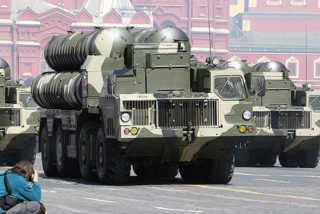

… from Russia Today, Moscow

[ Editor’s Note: It was a long time coming, but Iran is getting its S-300 defensive missiles finally in place, strangely guarding a facility that is no longer producing enriched uranium, but still represents a huge infrastructure facility that has to be protected as probably the deepest command base that Iran has.
The next decade will see a major shift in regional allied technology sharing and joint production of cutting edge weapons systems to spread the R&D costs out and keep the per unit costs low, so the numbers needed to protect such a vast region as Eurasia are affordable.
All this will be for naught for whomever is caught playing second fiddle on the electronic warfare battlefield, where the design of one computer chip or a piece of software might determine whose planes fall out of the sky because their electronics shut down.
It will be a bitter, and costly defeat for the loser, unless both can do the same to each other, which would generate a Mexican standoff, no offense to Mexico… Jim W. Dean ]
____________
– First published … August 29, 2016 –
Iran has deployed a Russian-made S-300 surface-to-air missile defense system at its Fordow uranium enrichment facility, the country’s state media have reported, as cited by Reuters.
“Our main priority is to protect Iran’s nuclear facilities under any circumstances,” Brigadier General Farzad Esmaili, commander of the Islamic Revolutionary Guards Corps’ (IRGC) air defense force, told state TV.

Esmaili did not say whether the new missile defense system was operational, however the IRGC commander did say that, “Today, Iran’s sky is one of the most secure in the Middle East.”
The Fordow site, which is around 100km south of the capital Tehran, has not enriched any uranium since a nuclear deal between Iran and six international powers came into effect in January.
The deal was signed in 2015 and was aimed at curbing Iran’s nuclear program. In return, Tehran saw the lifting of sanctions that had stifled economic growth.
The contract to deliver S-300s to Iran was put on hold in 2010 by then-President Dmitry Medvedev due to UN sanctions imposed on Iran.
Moscow said at the time that the delivery of the missile defense system would upset the balance of power in the region and escalate tensions.
The contract was revived in April of 2015 by President Vladimir Putin after Iran and six leading world powers signed a nuclear deal, which addressed concerns about Tehran achieving a potential breakthrough that would allow it to produce nuclear weapons.
In May, Iran announced that it had deployed the S-300 defense systems at its Khatam al-Anbia Air Defense Base. The Fordow site is built 90 meters below a mountain, with its location being revealed by the West in 2009.
The deployment comes just over a week after Tehran unveiled its Bavar-373 air defense complex at a military expo. The system was developed as an alternative to the S-300 and is set to go into production later this year.
“We did not intend to make an Iranian version of the S-300 – we wanted to build an Iranian system, and we built it,” Iran’s Minister of Defense Hossein Dehghan said. The weapon was successfully test-fired for the first time in August 2014.
____________

Jim W. Dean is VT Editor Emeritus. He was an active editor on VT from 2010-2022. He was involved in operations, development, and writing, plus an active schedule of TV and radio interviews. He now writes and posts periodically for VT.
ATTENTION READERS
We See The World From All Sides and Want YOU To Be Fully InformedIn fact, intentional disinformation is a disgraceful scourge in media today. So to assuage any possible errant incorrect information posted herein, we strongly encourage you to seek corroboration from other non-VT sources before forming an educated opinion.
About VT - Policies & Disclosures - Comment Policy




Comments are closed.